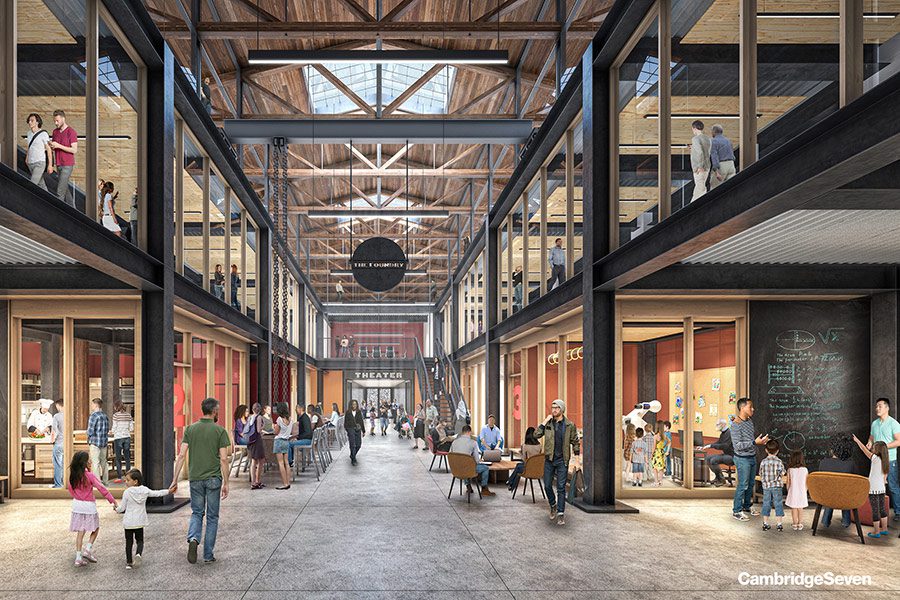Restoration of Cambridge’s Foundry Preserves Important Stories, Unlocks New Futures
Banker & Tradesman - February 10, 2020

Forging Community: Building Will Be Home to Arts, Workforce Training
By Justin Crane
The Foundry Building in East Cambridge, like countless old industrial buildings, has seen multiple uses over the last century. Yet through the stewardship of the city of Cambridge and a twist of fate, the building will rediscover its original purpose of innovative manufacturing. This 21st century reincarnation comes with unique challenges; however, the irreplaceable value of a historic building makes renovation the right choice for the Cambridge community.
The building has a notable past and has been declared a landmark by the city. The inventor George F. Blake and his steam pump manufacturing company constructed the building in 1890, proclaiming that it would feature “an entirely new feature in foundries, two electric traveling cranes with a capacity of 35 tons each.” The Foundry continued to produce pumps until 1927; after that time the building hosted a truck manufacturer, a taxi company and, after 1982, a telecom office building.
Life sciences real estate developer Alexandria Real Estate Equities transferred ownership of the building to the city in 2010 with the stipulation that a portion be dedicated to community use. A subsequent Cambridge Redevelopment Authority community process generated a new building program that would facilitate access for residents to the dynamism of Kendall Square through a space for the visual and performing arts, entrepreneurship, technology and workforce education.
These new uses cannot be accommodated without significant interventions, including the removal of three 1980s infill floors and an entrance that does not comply with current building codes for structure and accessibility. New steel framing on pile foundations, structurally separate from the historic building, will support new composite metal deck floors, and new braced frames will strengthen the historic masonry end walls.
Meeting the city’s progressive sustainability goals of LEED Gold certification and net zero carbon emissions also requires additional consideration for the historic architecture. Installing insulation over the original masonry walls would create unwelcome condensation. Instead, energy efficiency measures will focus on window replacements and added roof insulation. Accompanying these technical difficulties is the architectural design challenge of making an introverted industrial building into a community center that is welcoming to all.
Challenging Restoration Worth Result
Despite these challenges, restoring the historic building adds value not easily created in new buildings. The Foundry walls are constructed from historic, water-struck brick, which is noticeably different from mass-produced, contemporary materials. The heavy timber structure is solid wood, a feature that could not be affordably recreated today due to the absence of old-growth timber. The authenticity of the textured and careworn materials makes the Foundry Building immediately suitable for the makers and artists that will move in and shape the building, as needed, through their own craft.
Additionally, as the Foundry was constructed before the widespread use of modern building systems, it features extensive passive lighting through large windows and skylights, and an inherent ability to maintain relatively comfortable temperatures via its thick walls, both attributes that should be celebrated for their contributions to environmental sustainability.
Finally, buildings can be the last palpable link to an important part of a community’s history. The Foundry Building employed numerous immigrants to the East Cambridge neighborhood, including many women. While these women performed the same tasks as men, they were paid at half the rate. Ensuing protests led to the passage of the first Minimum Wage Act for Women in the country in 1912. These events will be memorialized via graphics and text integrated into the architecture, providing inspiration for the building’s users that would lose much of its power amidst new construction.
The value of historic buildings comes from the materials, the quality of construction, but also potentially, from the activities that happened within. With the renovation of the Foundry Building, the city of Cambridge is seizing a notable opportunity to create a contemporary and forward-thinking building type – a civic space for the arts and for hands-on education – that not only takes advantage of historic architecture but also re-imagines its original use for the 21st century.